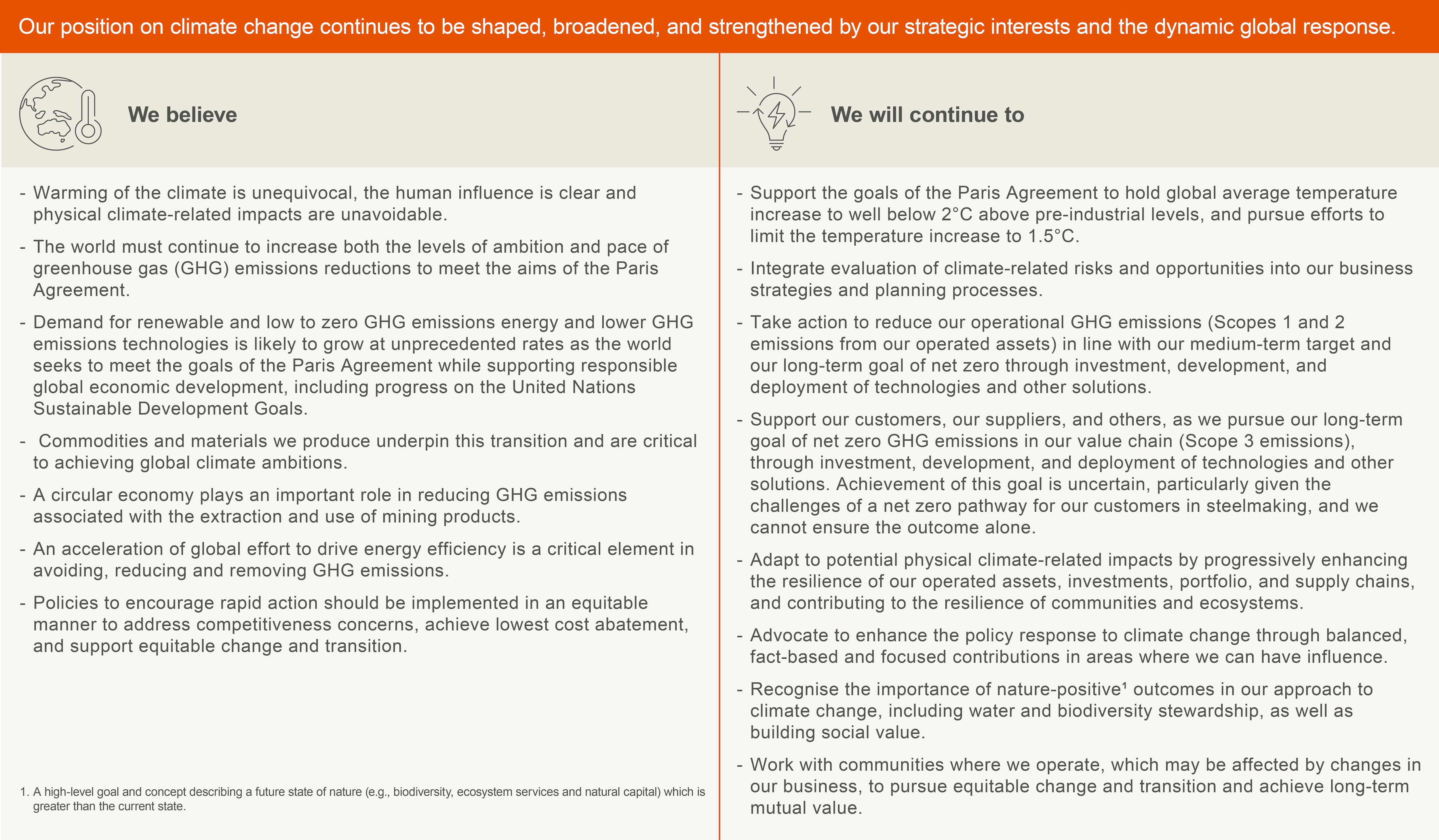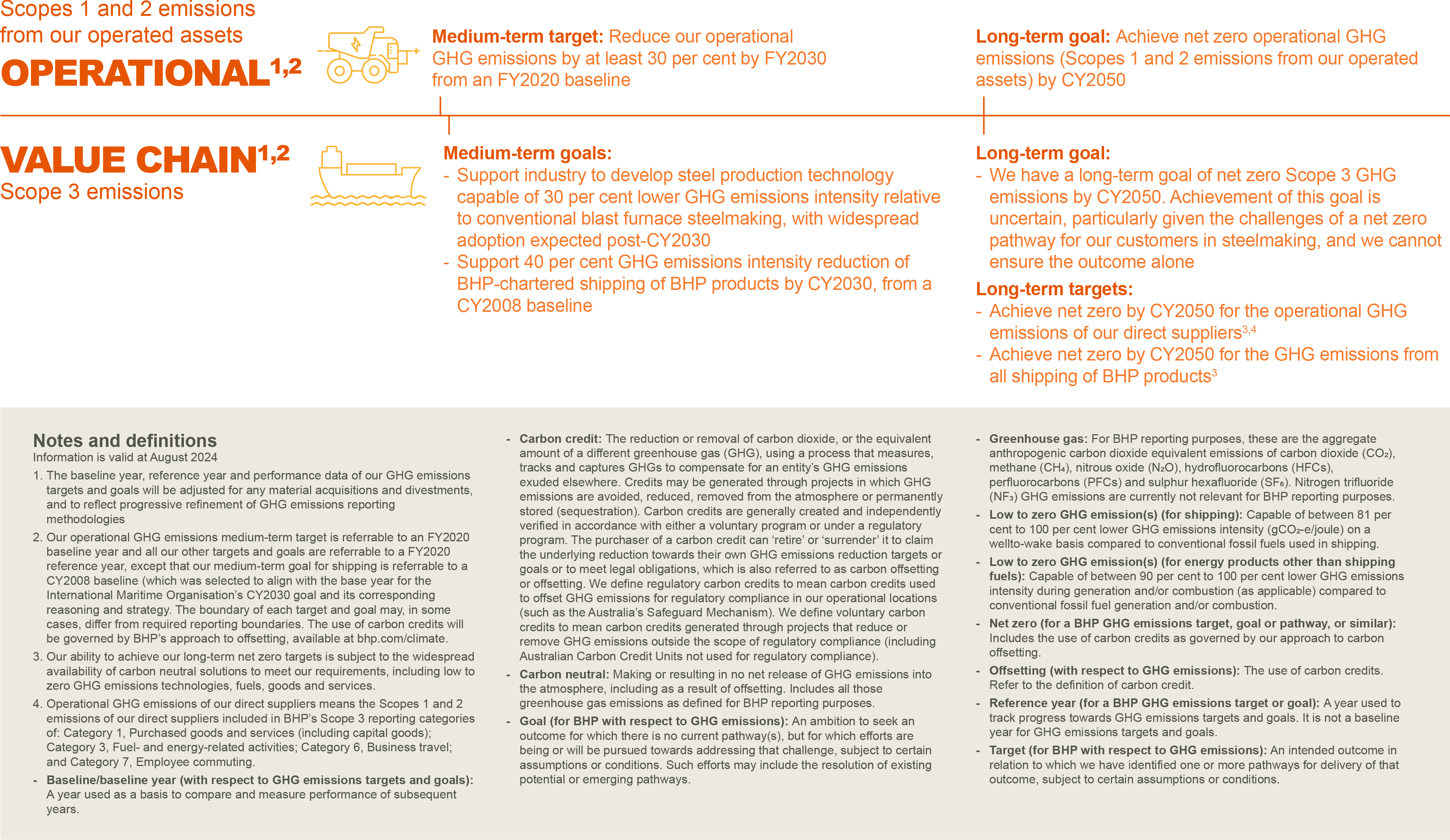
BHP's Climate Transition Action Plan (CTAP) 2024
Our CTAP 2024 sets out our climate change strategy, commitments, targets and goals, and forward-looking plans. It continues our multi-decade focus on climate and underscores our commitment to becoming a more sustainable and resilient business. This is important work that will help set us up to grow long-term value for shareholders.
Our position on climate change

Our GHG emissions targets and goals

-
Governance and oversight
Climate change and climate transition planning is a material governance and strategic issue for our Board and management.
The Board is informed through board papers, progress updates from management, material risks reports, presentations from external subject matters experts and reports from the chair of each Board Committee following Committee meetings. Climate-related topics are also incorporated into Director induction programs, ongoing training, external speakers and site visits to assist the directors in their oversight.
The Board will monitor and oversee progress against our GHG emissions targets and goals and the key commitments detailed in our CTAP 2024. The Sustainability Committee, with assistance from the management-level Sustainability and ESG Steering Committee, will oversee BHP’s implementation and performance against our CTAP 2024 and climate-related matters.
-
Engagement
Achieving the goals of the Paris Agreement will require supportive policy across jurisdictions, globally. We believe BHP can best support policy development by ensuring we meet our own GHG emissions targets, goals and strategies, continuing to make the case for the economic opportunities arising from the energy transition, and focusing on those policy areas where we are likely to have the greatest ability to influence change.
Policy advocacy
We are committed to conducting our advocacy on government climate policy (direct and indirect) consistent with the goals of the Paris Agreement. We translate this into action by using our Climate Policy Principles in how we advocate (direct) and how we encourage industry associations where we are a material member to advocate (indirect). More information on our approach to direct advocacy is available here, while we detail our approach to indirect advocacy here.
Shareholder engagement
We use a range of formal and informal communication channels to seek to understand and take into account the views of shareholders.
Throughout the year, we engage with shareholders through results roadshows and other investor engagement meetings, including on key issues such as climate change, industry associations and social value. BHP also hosts live webcasts and Q&A sessions with our senior leaders for shareholders to directly ask questions of management, including on corporate governance and ESG matters, steel decarbonisation technologies, strategy, finance and operating performance.
We also facilitate and encourage shareholder participation at our Annual General Meeting (AGM). The AGM provides an update for shareholders on our performance and offers an opportunity for shareholders to ask questions and vote.
-
Disclosure
We are committed to providing transparency over our climate-related governance, risks (threats and opportunities), strategy, commitments, and GHG emissions targets and goals, enabled through regular and comprehensive disclosures.
We also recognise the importance of investors and other stakeholders being able to understand the potential impacts on BHP’s financial position from climate-related risks (threats and opportunities). In our Financial Statements in the BHP Annual Report 2024, we capture potential financial statement impacts, where material or relevant, of the assumptions, plans and actions of our climate change strategy and the consideration of climate-related risks in the assessment of significant areas of judgement and estimation required for the presentation of the financial statements.
Our most recent climate-related disclosures can be found in the:
- BHP Climate Transition Action Plan 2024
- BHP Annual Report 2024, Operating and Financial Review 6.9 - Climate change
- BHP Annual Report 2024, note 16 'Climate change' to the Financial Statements
- BHP ESG Standards and Databook 2024
- BHP GHG Emissions Calculation Methodology 2024
Additional climate-related disclosures are available in the Sustainability case studies, organisational boundary, definitions, disclaimers and downloads section at the bottom of this page. Prior year versions of some of these documents, together with previous climate-related reports are available on the Past reports page.
-
Performance
Our most recent climate-related performance data can be found in the:
- BHP Climate Transition Action Plan 2024
- BHP Annual Report 2024, Operating and Financial Review 6.9 - Climate change
- BHP ESG Standards and Databook 2024
Case studies, BHP Insights and presentations
Sustainability case studies, organisational boundary, definitions & disclaimers, and downloads
Prior year versions of some of the listed documents are available on the Past reports page.-
BHP Annual Report 2024
pdf
16192519

-
BHP Climate Transition Action Plan 2024
pdf
8480121

-
Sustainability reporting organisational boundary, definitions and disclaimers
pdf
161998

-
Límite organizativo de los informes de sostenibilidad, definiciones y cláusulas de exención de responsabilidad
pdf
6277

-
BHP ESG Standards and Databook 2024
xlsx
2555913

-
CDP 2023 Submission Not Graded
pdf
1053064

-
BHP Climate Transition Action Plan 2021
pdf
2677572

-
BHP Climate Change Report 2020
pdf
3112031

-
Climate Change: Portfolio Analysis View after Paris
pdf
3001458

-
BHP GHG Emissions Calculation Methodology 2024
pdf
1028031

-
Case studies
















